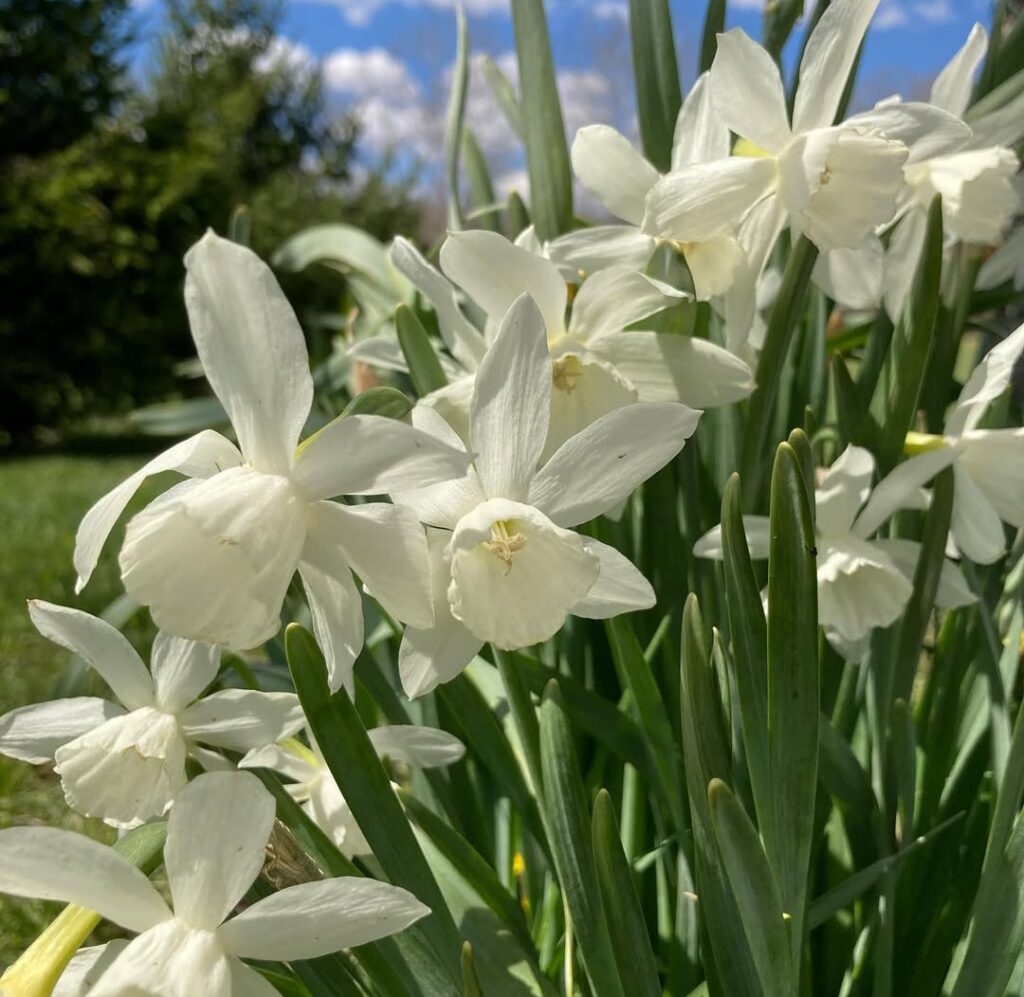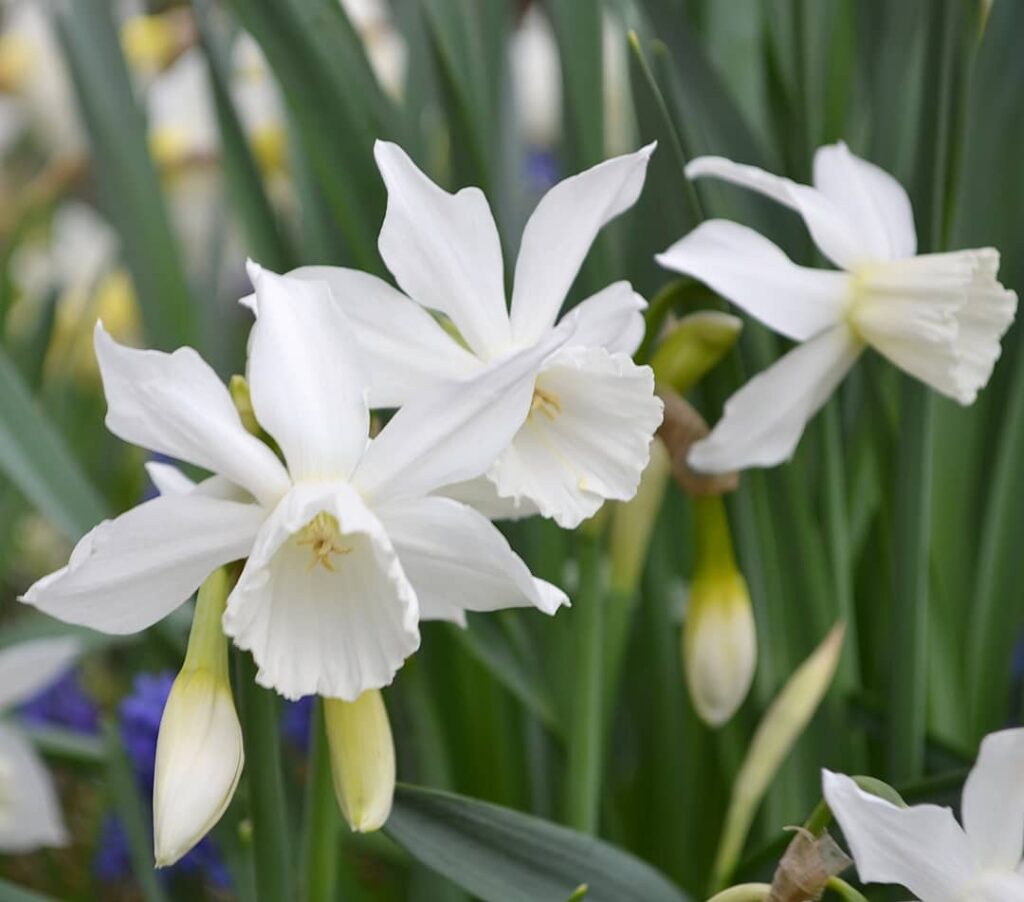
White daffodils are the purest symbols of spring’s arrival, adding elegance and brightness to any garden. Their trumpet-shaped blooms and snowy petals make them stand out, whether planted in clusters or scattered among other flowers. Around the world, daffodils brighten gardens with their cheery appearance . But to enjoy these dazzling blooms year after year, proper care is essential. If you’re eager to keep your white daffodils blooming beautifully, these 10 best care secrets will help your daffodils flourish like never before!

- 1 1. Choose the Right Location
- 2 2. Planting Time Matters
- 3 3. Use Well-Draining Soil
- 4 4. Watering Wisdom
- 5 5. Feed Them Right
- 6 6. Mulch for Moisture and Protection
- 7 7. Don’t Cut the Leaves Too Soon
- 8 8. Pest and Disease Watch
- 9 9. Deadheading Done Right
- 10 10. Divide for Bigger Blooms
- 11 Bonus Tip: Companion Planting Ideas
- 12 FAQs About White Daffodils
1. Choose the Right Location
Although they prefer full sun to partial shade, white daffodils require at least six hours of direct sunshine per day to flourish.Proper sunlight helps the flowers bloom vigorously and ensures the plants develop strong, healthy growth. If your daffodils are planted in too much shade, they may struggle to bloom and become weak. Additionally, pick a site that’s sheltered from strong winds; while they need sunlight, they also benefit from a little protection from harsh gusts. Consider avoiding planting daffodils near large trees, which may compete for essential nutrients and water.
Bonus Tip: A sunny location with well-draining soil will help your daffodils reach their full potential, offering the best possible conditions for growth.
2. Planting Time Matters
Timing your planting is crucial for a successful daffodil display.White daffodil bulbs are best planted in the fall, usually from September to November.This allows the bulbs time to establish strong roots before the ground freezes, ensuring they are ready to shoot up as soon as spring arrives. Planting too early or too late can lead to weak growth or delayed blooming. Be sure to plant your daffodils before the first frost hits, as they need time to adapt to the cold weather.
Pro Tip: When planting the bulbs, make sure to place them about 6 inches deep, with the pointed end facing upward. This depth provides the ideal balance between stability and accessibility to nutrients.
3. Use Well-Draining Soil
One of the most critical factors in keeping your white daffodils healthy is ensuring they are planted in well-draining soil. Daffodils dislike having their roots sitting in wet soil for long periods, which can lead to bulb rot and other fungal diseases. To achieve the best soil conditions, amend your garden bed with sand, compost, or perlite to enhance drainage. A well-draining, slightly acidic to neutral soil (pH 6-7) is perfect for daffodils, as it allows the bulbs to thrive without the risk of rot. The key is to avoid waterlogged soil, which can lead to serious issues.
Tip: Avoid heavy, clay-rich soil that retains too much moisture, as this can smother the daffodil bulbs and lead to decay.
4. Watering Wisdom
While daffodils don’t require constant watering, they do need regular moisture during their growing season. Give your bulbs plenty of water after planting to aid in their establishment.Once the shoots emerge in spring, make sure the soil stays moist but not soggy. Overwatering can cause the bulbs to rot, especially if the soil lacks good drainage. During the flowering season, it’s important to keep the soil moist but not overly wet. As the flowers fade and the foliage begins to die back, reduce watering to avoid over-hydrating the bulbs.
Reminder: Daffodils enter a dormant phase after flowering, so avoid watering during this period in the summer when the bulbs need to rest. Giving them a dry period allows them to rejuvenate for the following season.
5. Feed Them Right
White daffodils don’t require heavy feeding, but providing them with the right nutrients at key times helps ensure vibrant blooms. In early spring, when the shoots first emerge, feed your daffodils with a low-nitrogen fertilizer (such as 5-10-10), which helps encourage flower production rather than excessive leafy growth. Apply the fertilizer around the base of the plants to provide nutrients directly to the roots. After the flowers have faded, another application of fertilizer can help replenish the energy in the bulb, ensuring a strong, healthy plant next season.
Avoid: High-nitrogen fertilizers, as they encourage lush foliage growth rather than robust flowers.
6. Mulch for Moisture and Protection
Mulching is an essential step in ensuring the health of your white daffodils, especially in areas with fluctuating temperatures. A 2-3 inch layer of mulch (such as straw, leaf mold, or shredded bark) helps retain moisture in the soil during dry spells, reducing the need for frequent watering. Mulch also acts as a natural insulator during winter, protecting the bulbs from extreme cold and frost. In warmer climates, mulch helps regulate the soil temperature, preventing the soil from becoming too hot and dry during the summer months.
Winter Bonus: In colder areas, a layer of mulch provides valuable insulation for the bulbs, ensuring they remain healthy through winter.
7. Don’t Cut the Leaves Too Soon
It’s tempting to tidy up your garden once the daffodils finish blooming, but cutting the leaves too soon can hinder the bulb’s ability to regenerate for the next season. The leaves are essential for the plant to gather nutrients and energy that will nourish the bulb through the summer and ensure next year’s growth. Allow the foliage to die back naturally over the course of 6 weeks after flowering, as this process helps replenish the bulb’s energy reserves. Only cut the leaves once they have fully turned yellow and dried up.
Reminder: Cutting the foliage too early can reduce the chances of your daffodils blooming as robustly the following year.
8. Pest and Disease Watch
White daffodils are relatively pest-resistant, but it’s still important to keep an eye out for a few common garden threats. Aphids, which often infest the buds, can damage your daffodils by sucking sap from the plants and potentially transmitting diseases. Bulb rot, a fungal disease caused by overwatering, can also harm daffodils if the soil remains too wet for extended periods. Additionally, narcissus fly, a pest that targets daffodils, may occasionally infest the bulbs.
Prevention Tips: Rotate your planting areas each year to avoid pests, and be sure to inspect bulbs before planting them. Healthy bulbs will be firm and free from visible damage.
9. Deadheading Done Right
Deadheading, or removing spent flowers, is essential for maintaining a healthy white daffodil plant.It’s a good idea to remove the flower heads after the blooms fade so the plant doesn’t waste energy producing seeds.This allows the daffodil to focus its energy on strengthening the bulb for next year’s growth. However, don’t cut the stem or foliage prematurely, as these parts are vital for storing energy in the bulb.
How to Deadhead: Pinch or cut off the spent flowers just below the bloom, leaving the stem and foliage intact. Let the plant do the rest!
10. Divide for Bigger Blooms
If your daffodils have been in the same spot for several years, their clumps may become overcrowded, leading to smaller or fewer blooms. Dividing daffodils is a simple way to rejuvenate your plants and improve flowering. To divide, dig up the bulbs after the foliage has died back (usually late spring or early summer), gently separate the bulbs, and replant them in fresh, well-drained soil. Dividing your bulbs every 3-5 years helps prevent overcrowding and encourages healthy, vibrant blooms.
How to Divide: Carefully dig up the clumps, separate the bulbs without damaging them, and replant in a sunny, well-drained location.
Bonus Tip: Companion Planting Ideas
White daffodils make an excellent companion plant for many other spring flowers. Pair them with grape hyacinths for a burst of blue, or with tulips to create stunning color contrasts. Forget-me-nots can also complement daffodils, adding a delicate touch of blue. For contrast in the summer months, hostas work well, offering lush green foliage after the daffodils finish blooming.
Bonus Advantage: Companion plants can also help deter pests naturally, offering protection and creating a harmonious garden design.
White daffodils are beautiful, low-maintenance plants that reward gardeners with stunning blooms every spring. By following these 10 care secrets, you can ensure your daffodils remain healthy and vibrant year after year. With a little attention to detail, you’ll enjoy the elegance and charm of these gorgeous flowers, and your garden will be the envy of all who visit.
FAQs About White Daffodils
What are White Daffodils?
White daffodils are a variety of daffodil known for their pure white flowers with a trumpet-shaped center. These elegant flowers are a symbol of spring and bring brightness to gardens. White daffodils are easy to grow and require minimal care, making them a popular choice among gardeners.
Can White Daffodils grow in pots?
Yes, white daffodils can be grown in pots. Ensure the container has drainage holes and use a good-quality potting mix with added sand or perlite for better drainage. Place the pot in a sunny location, and make sure to water the plants regularly without allowing the soil to become waterlogged.
How often should I water White Daffodils?
Water white daffodils regularly during their growing season to keep the soil consistently moist but not soggy. Once the flowers have bloomed, reduce watering to allow the plants to enter dormancy. Overwatering can lead to bulb rot, so be sure to maintain proper drainage.
Can I plant White Daffodils with other flowers?
Yes, white daffodils can be paired with many other flowers to create stunning garden displays. Try planting them alongside tulips, grape hyacinths, or crocuses for a colorful spring show. White daffodils also look lovely with evergreen shrubs or perennials like hostas for a year-round garden.
What should I do with White Daffodils after they bloom?
Once white daffodils have finished blooming, deadhead the spent flowers to prevent the plant from wasting energy on seed production. Allow the foliage to die back naturally for about 6 weeks, and only cut it back once it has turned yellow.This aids in the bulbs’ nutrient storage for the following growing season
Do White Daffodils attract pests?
White daffodils are generally pest-resistant. However, they can sometimes be affected by aphids, narcissus flies, or bulb rot if the soil is too wet. Regularly check your plants for any signs of pest infestation and take preventive measures, such as using insecticidal soap or ensuring good drainage.
Can White Daffodils survive winter?
White daffodils are quite hardy and can survive winter in most climates, particularly when planted in well-draining soil. In colder regions, applying a layer of mulch around the bulbs in late fall helps protect them from extreme temperatures and frost.
Do White Daffodils need special fertilizer?
White daffodils benefit from a low-nitrogen fertilizer, especially in early spring when the shoots first appear. Use a balanced fertilizer with a ratio of 5-10-10, which will encourage healthy blooms without excessive leaf growth. Steer clear of high-nitrogen fertilisers since they may inhibit blossoming.
How do I divide White Daffodils?
To divide white daffodils, dig up the bulbs after the foliage has died back, usually in late spring or early summer. Gently separate the bulbs and replant them in a sunny, well-drained spot. Dividing the bulbs every 3-5 years helps prevent overcrowding and ensures better blooms.







